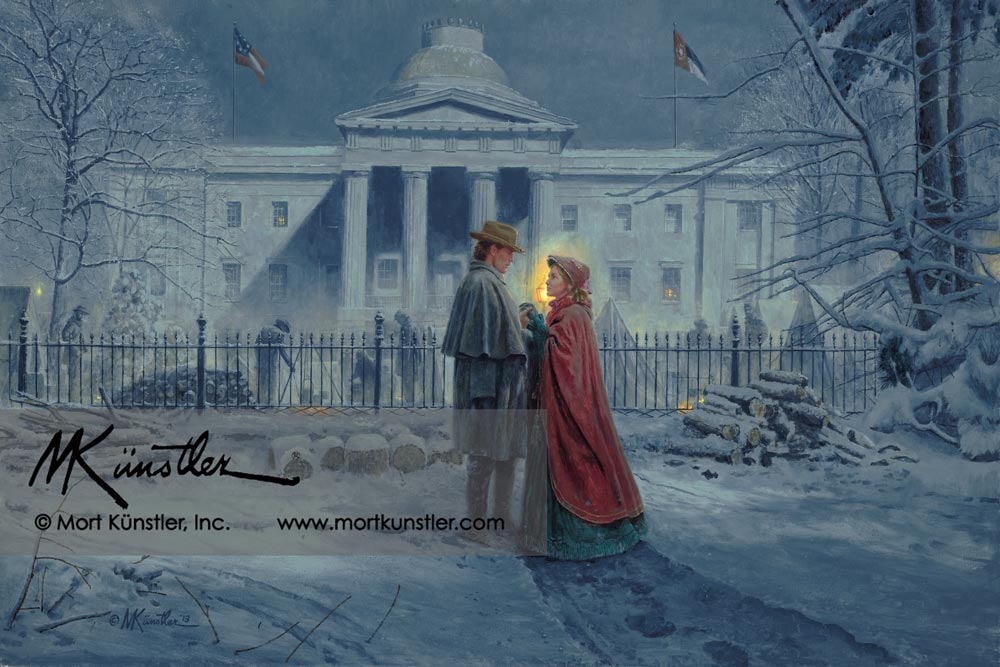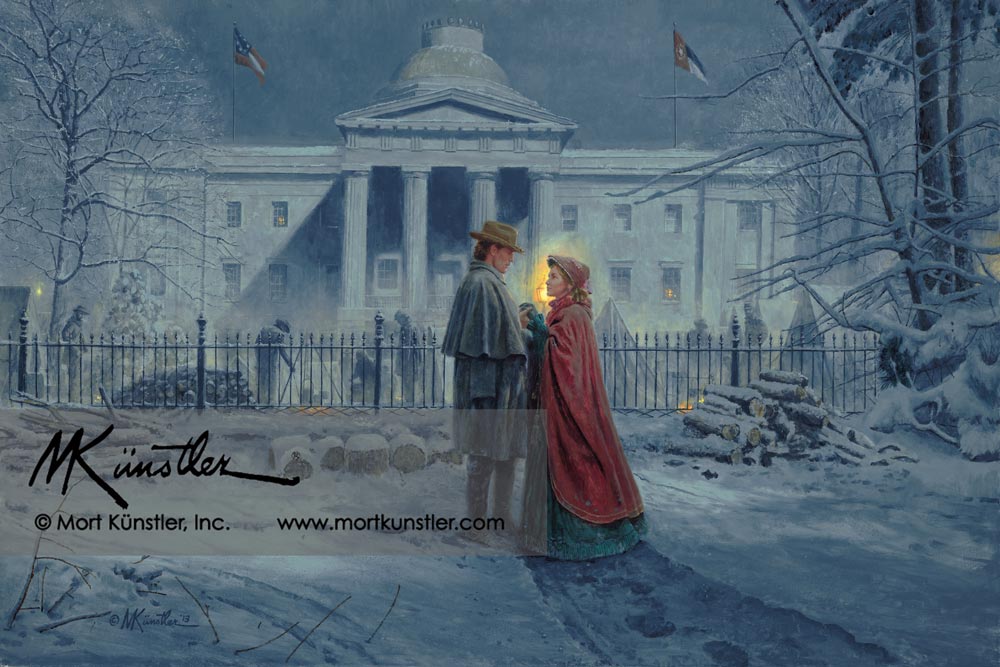The Official Mort Künstler Website
Capitol Farewell - limited edition print
Capitol Farewell - limited edition print
Raleigh, North Carolina, February 5, 1863
Regular price
$225.00 USD
Regular price
Sale price
$225.00 USD
Unit price
per
Tax included.
Shipping calculated at checkout.
Couldn't load pickup availability
The Premier and Collector’s editions are shipped FREE* and UNSTRETCHED. Stretching is available at an additional charge. Please contact us for pricing: 800-850-1776 or info@mortkunstler.com.
Custom framing is available for this print. Please call 800-850-1776 or email info@mortkunstler.com for more information.
2013 ANNUAL SNOW PRINT
A TRIBUTE TO THE LEGEND SERIES III/VIII
I Shenandoah Strategy
II Pickett's Charge
III Capitol Farewell
IV Mr. Lincoln Comes to Gettysburg
V “...none to caress...”
VI The Great Beefsteak Raid
VII An Apple for Traveller
VIII Respect of an Army
LIMITED EDITION PRINTS
Paper Prints
Reproduction technique: Fine offset lithography on neutral pH archival quality paper using the finest fade-resistant inks.
Each print is numbered and signed by the artist and accompanied by a Certificate of Authenticity.
Image Size: 17” x 25½” • Overall Size: 23” x 30½”
Signed & Numbered • Edition Size: 350
Signed Artist’s Proof • Edition Size: 50
Giclée Canvas Prints
Reproduction technique: Giclées are printed with the finest archival pigmented inks on canvas.
Each print is numbered and signed by the artist and accompanied by a Certificate of Authenticity.
Signature Edition Size: 18” x 27”
Signed & Numbered • Edition Size: 50
Artist’s Proof • Edition Size: 10
Classic Edition Size: 21” x 32”
Signed & Numbered • Edition Size: 50
Artist’s Proof • Edition Size: 10
Premier Edition Size: 26” x 39”
Signed & Numbered • Edition Size: 15
Artist’s Proof • Edition Size: 5
Collector’s Edition Size: 37” x 56”
Signed & Numbered • Edition Size: 5
Artist’s Proof • Edition Size: 2
Historical Information
Like many Southern states, North Carolina’s entrance into the American Civil War began at its Capitol. On May 20, 1861, state legislators signed the Ordinance of Secession in the House of Commons chamber. This officially ushered the Tar Heel State out of the Union and into the Confederacy. Following the final signature, a handkerchief was waved from the window of the office of the Speaker of the House announcing the state’s secession to the crowd below. A great celebration erupted on the building’s Union Square, including a 100-round artillery salute and music from a military band.
According to a local legend, the first blood shed for North Carolina during the war occurred that day, as a bulldog, startled by a gun salute, severely bit one of the artilleryman of the First North Carolina Artillery, also known as Manly’s Battery. For the next four years the building hosted the state’s wartime legislatures.
Although Governor Zebulon B. Vance maintained an office in the southwest suite on the first floor, the Capitol building served the war effort far beyond a meeting place for politicians. It was also used as a supply depot and a gathering place for the ladies of the town who met in the rotunda to fashion uniforms, haversacks and bandages. Confederate troops were brought to the capital city for training and then sent to the front lines. They often used the Capitol’s surroundings for encampments. The building itself became a fixture in the hearts and minds of the soldiers and civilians who busily occupied its halls and grounds.
In April of 1865 Raleigh and the Capitol witnessed the war firsthand as General William T. Sherman’s army, led by Judson Kilpatrick’s Third Cavalry Division, marched into town and began the occupation of the city by Federal forces. According to the North Carolina Office of Archives and History, “The Capitol itself was spared the total destruction that had befallen the old statehouse in Columbia, South Carolina. Before retreating westward, Governor Vance sent a peace delegation, led by former Governors David L. Swain and William A. Graham, to Sherman asking that the Capitol, with its library and museum, be spared. As a result, the Capitol suffered little damage.”
Despite a reprieve from excessive destruction, North Carolina’s official copy of the Bill of Rights was stolen by an Ohio soldier. That document would not be returned to the state until 2003, when it was surrendered to the North Carolina branch of the U.S. Marshal’s Service. On April 14, 1865, General John A. Logan organized the Society of the Army of the Tennessee, one of the country’s first post-war veteran’s organizations, in the Treasurer’s Office on the first floor. From then on, the North Carolina State Capitol in Raleigh became a place of healing as the residents of the city and state began to recover from the consequences of the war.
Mort Künstler’s Comments
In 1995, I had my first one-man exhibition of original paintings at the North Carolina Museum of History in Raleigh. This was a special event where I unveiled and signed limited edition prints of the painting Winter Riders. That release was a huge success and eighteen years later, I had another show at the museum with more than thirty originals and another unveiling and print signing. What a pleasure this was for me, as my work continued to go full circle. With high hopes of repeating the wonderful reception of years ago, I decided to reprise some of the same elements in this new painting, Capitol Farewell.
View full details
* Free shipping within the Continental United States.
Custom framing is available for this print. Please call 800-850-1776 or email info@mortkunstler.com for more information.
2013 ANNUAL SNOW PRINT
A TRIBUTE TO THE LEGEND SERIES III/VIII
I Shenandoah Strategy
II Pickett's Charge
III Capitol Farewell
IV Mr. Lincoln Comes to Gettysburg
V “...none to caress...”
VI The Great Beefsteak Raid
VII An Apple for Traveller
VIII Respect of an Army
LIMITED EDITION PRINTS
Paper Prints
Reproduction technique: Fine offset lithography on neutral pH archival quality paper using the finest fade-resistant inks.
Each print is numbered and signed by the artist and accompanied by a Certificate of Authenticity.
Image Size: 17” x 25½” • Overall Size: 23” x 30½”
Signed & Numbered • Edition Size: 350
Signed Artist’s Proof • Edition Size: 50
Giclée Canvas Prints
Reproduction technique: Giclées are printed with the finest archival pigmented inks on canvas.
Each print is numbered and signed by the artist and accompanied by a Certificate of Authenticity.
Signature Edition Size: 18” x 27”
Signed & Numbered • Edition Size: 50
Artist’s Proof • Edition Size: 10
Classic Edition Size: 21” x 32”
Signed & Numbered • Edition Size: 50
Artist’s Proof • Edition Size: 10
Premier Edition Size: 26” x 39”
Signed & Numbered • Edition Size: 15
Artist’s Proof • Edition Size: 5
Collector’s Edition Size: 37” x 56”
Signed & Numbered • Edition Size: 5
Artist’s Proof • Edition Size: 2
Historical Information
Like many Southern states, North Carolina’s entrance into the American Civil War began at its Capitol. On May 20, 1861, state legislators signed the Ordinance of Secession in the House of Commons chamber. This officially ushered the Tar Heel State out of the Union and into the Confederacy. Following the final signature, a handkerchief was waved from the window of the office of the Speaker of the House announcing the state’s secession to the crowd below. A great celebration erupted on the building’s Union Square, including a 100-round artillery salute and music from a military band.
According to a local legend, the first blood shed for North Carolina during the war occurred that day, as a bulldog, startled by a gun salute, severely bit one of the artilleryman of the First North Carolina Artillery, also known as Manly’s Battery. For the next four years the building hosted the state’s wartime legislatures.
Although Governor Zebulon B. Vance maintained an office in the southwest suite on the first floor, the Capitol building served the war effort far beyond a meeting place for politicians. It was also used as a supply depot and a gathering place for the ladies of the town who met in the rotunda to fashion uniforms, haversacks and bandages. Confederate troops were brought to the capital city for training and then sent to the front lines. They often used the Capitol’s surroundings for encampments. The building itself became a fixture in the hearts and minds of the soldiers and civilians who busily occupied its halls and grounds.
In April of 1865 Raleigh and the Capitol witnessed the war firsthand as General William T. Sherman’s army, led by Judson Kilpatrick’s Third Cavalry Division, marched into town and began the occupation of the city by Federal forces. According to the North Carolina Office of Archives and History, “The Capitol itself was spared the total destruction that had befallen the old statehouse in Columbia, South Carolina. Before retreating westward, Governor Vance sent a peace delegation, led by former Governors David L. Swain and William A. Graham, to Sherman asking that the Capitol, with its library and museum, be spared. As a result, the Capitol suffered little damage.”
Despite a reprieve from excessive destruction, North Carolina’s official copy of the Bill of Rights was stolen by an Ohio soldier. That document would not be returned to the state until 2003, when it was surrendered to the North Carolina branch of the U.S. Marshal’s Service. On April 14, 1865, General John A. Logan organized the Society of the Army of the Tennessee, one of the country’s first post-war veteran’s organizations, in the Treasurer’s Office on the first floor. From then on, the North Carolina State Capitol in Raleigh became a place of healing as the residents of the city and state began to recover from the consequences of the war.
Mort Künstler’s Comments
In 1995, I had my first one-man exhibition of original paintings at the North Carolina Museum of History in Raleigh. This was a special event where I unveiled and signed limited edition prints of the painting Winter Riders. That release was a huge success and eighteen years later, I had another show at the museum with more than thirty originals and another unveiling and print signing. What a pleasure this was for me, as my work continued to go full circle. With high hopes of repeating the wonderful reception of years ago, I decided to reprise some of the same elements in this new painting, Capitol Farewell.





